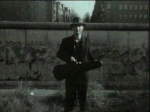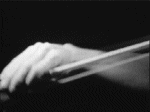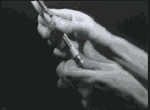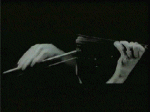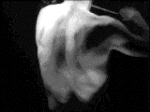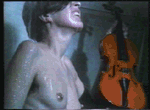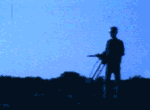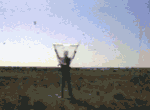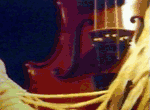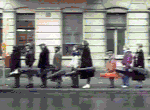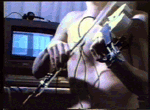 | |||||||

|
Film & Video The Jon Rose Film & Video Archive |
|
|
This page is a summary of the Super 8 performance films made by Jon Rose (1985-1989). Also listed are the videos of performances shot by Konstanze Binder in Berlin (1990-1998) and two productions made for ORF (Austrian television). All three 'Relative Violin' and 'Flying Lessons' Super 8 films were used as visual backdrop for live performances on violin or 19 string cello. SUPER 8 FILMS Relative Violin 1. 'Relative Violin 1.' was a double projection with stereo amplified 19 string cello. It received its first performance at the Gallery Of New South Wales, Australia in 1985. Later performances took place at The Experimental Media Foundation, New York; The Atonal Festival, Berlin; The Shaffy Sound Festival, Amsterdam; and dozens of other venues in Germany, Austria, Switzerland and Holland. It was shot on colour and black & white Super 8 film. Camera work was by Garry Warner, John Jacobs and Jon Rose. The film/performance was a rhythmic interplay between contrasting cut up, fast moving images and fast shifting sonic displays from the live cello. The visual material came from two primary sources. Firstly, footage concentrating on various techniques and physicality of violin playing and secondly, images of the Australian outback shot from a moving car. The swish of the bow stroke often acted as a visual editing procedure and used to divide the landscape into contrasting fields of activity. The juxtaposition of violin action images in a landscape that doesn't give a damn makes for classic existentialist miss readings of environment. Apart from the 19 string cello and 5 string violin, other 'relative violins' were featured as figure against horizontal ground; notably the 16 string long neck violin, the 10 string double neck aeolian violin with sail, and perhaps the tour de force of the film - the triple neck, double piston, wheeling violin (shot on a desolate road near the mining town of Broken Hill, NSW). The last section of the film treated a broadcast of a cricket match with lots of violins and surrealist disregard, as did the weather, when a storm ended the game abruptly. Relative Violin 2. 'Relative Violin 2.' was a single projection number following on with ideas similar to the first film. It was commissioned and presented at The Inventionen Festival of New Music, Berlin 1989 as part of The Relative Violin Festival. The images for this were all European based. There were a number of found violin objects eg. statues with violins, violin puppet, kitsch violins; the continuing references to Man Ray's Violon D'Ingres; extended violin techniques; much violin psycho drama; severed fingers; violinist on the beach; dog attacks man with violin; some relevant East German tourist propaganda footage; duality references, as in pairs of backward looking soldiers and pairs of forward looking tits; and a whole cast of characters, including tramps, smart young women, and policmen, who were asked to carry a violin down a street for the first time in their lives. Relative Violin 3. 'Relative Violin 3.' consisted mostly of violin footage shot by the Berlin Wall in 1988 and again in 1989 as it was about to be pulled down (and was already porous). The Rosenberg Museum mounted a campaign against the willful destruction of this fond artifact, but as history records, to no avail. Flying Lessons 'Flying Lessons' is a Super 8 film featuring the dancing and erotic relationship between Laetitia Royackers and a pigeon that, one day, walked into her Amsterdam apartment and, when the film was finished, walked calmly out again. The pigeon showed no interest in the normal activity of birds, namely flying, so it was given 'flying lessons'. Lots of fluttering, lots of doors opening and shutting, some naked flesh, swinging bare light bulbs, the de rigeur pecking order, violins of course, and the americans show off how to do it with a NASA lift off. When Jon Rose performed it at the Leipzig International Jazz Festival in 1987, the audience responded with cries of 'Freedom' 'Away with State Oppression' etc. Some guys just don't get it do they? VIDEOS 1. The Rosenberg Museum Originally commissioned by ZDF (The second German television channel) but ditched by them after the initial payment. It seems a film about an East German maestro was not really a viable popular idea in the shortly to be unified Germany of 1990. The movie was shot in the form of a fake documentary about the museum which contained many of the instruments, artifacts, collections, research documents, medical experiments, scores, letters from Yehudi Menhuin, violin pedagogy, and archives associated with the good Doctor. Other running themes are a bus queue of violinists who never seem to get it together to get on the bus and eventually commit mass suicide (a bit like the DDR, the former East Germany; the only country to commit voluntary cultural, economic and political suicide in the history of the nation state; an archive of films that contain as many violin sequences as could be found (e.g. Charlie Chaplin, Peter Sellers, etc). And then there's 'that shower scene' and the world's biggest concrete violin (found leaning against a house in Neue Köln, Berlin); the latest non functional violin computer programs; dubious violin training videos for the children of the state (Hi there, all you Suzuki kids!) and a director of the museum who refuses to give away any word (let alone information) on the subject of Dr. Rosenberg. 2. Three Extracts from String 'em Up, Berlin 1998 Extracts from the premiere of 'Rosenberg Interactiv This is the first use of Tom Demeyer's 'Image-ine' program which enables real time midi control of images synchronous to the usual manipulation of sound and string samples. There are three kinds of image; the live video camera concentrating on the bowing techniques of the performer; stored Pict files; and video loops stored on hard disk. The physicality of performance is maintained through the real world to midi interface via midi bow, accelerometers and foot switches. All the images used come from the Rosenberg museum's collection of violin oddities and perversities. 3. Cafe Central Video and music performance by Jon Rose and Frank Schulte at Cafe Central, Innsbruck, Austria 1993, ORF; a Working Violinist's Monologue by an anonymous Rumanian fiddle player: FROM THE INNSBRUCK STADTANZEIGER 12.1.1993 "Well, I suppose I should welcome you to the cafe. Say something like 'Good Evening' or 'What beautiful skiing weather we've been having' or 'How did you find walking in the mountains' - but I won't. It all gets so depressing. Yes, that's right - I'm the house violinist here at Cafe Central and I can tell you that after 19 years in the job, you get a bit choosy about who you say hello to. I mean the clientele we get here is very mixed. You get your artist types like the bloke with the ridiculous hat - eh what was his name again - ah yeah Joseph Beuys. I think they built a theme park for him somewhere when he died - lots of hats and art theories. Yeah, those types (ars est celare artem). But let's face it, most of the people sitting in cafes are just plain, dull and boring. Fidel Castro thought so too. He dropped in for a stiff one last time he was over on a conference - he also seemed pretty depressed. Mind you I can see it from his side - he has to put up with all those American tourists! I didn't mind Fidel, played a few Latin numbers for him. Well he was a foreigner like me. I tell you, sometimes you play something that you think will go down well (you know culturally speaking very 'entre nous' and 'en rapport') and they burst into tears and start going on about 'Heimat' and all that rubbish. It's enough to make you take up the guitar or some other feeble instrument. Look the way I see it, if everybody forgot about where they were born we might just get the cafe violin business to pick up a bit. It's been going downhill for years. Like I said it can get very depressing. Oh there goes Dmitri again on his Tango number (tempus) yes, doesn't it just. He could have waited till I was out of the kitchen, I'm always a few bars late on this tune. It's the (faute de mieux) military thing, the Tango is really on about war - it's not really sexy at all. I mean you couldn't do it to a Tango now, could you? You would do yourself an injury! People have got some strange tastes. There was some young girl in here last week asking for Schoenberg. Schoenberg! In a cafe? Well, we did the best we could in the circumstances - a little arrangement of the third movement from his Variations for Orchestra Opus. 31, if I remember correctly. Let's face it, its all down to atmosphere. Most people in here wouldn't know their Monk from their Mozart. These days you can call anything 'jazz' and they all go 'How nice!' It's like what yuppies think they have to listen to, once they've bought the second red BMW. It's like they expect to graduate from their Disco days - get more sophisticated or something. Then they go around saying things like 'Hey, lighten up!' That really makes me depressed I can tell you. Then I start playing wrong notes. Then that usually makes me play more wrong notes - kind of, the wrong notes inspire other wrong notes. Then I really start enjoying playing all those wrong notes like Jascha Heifitz used to play. Then there are complaints. 'I say a bit non compos mentis!' And then they ask the management to turn me down. Turn me down! Jesus, you stupid deaf bat, I'm playing acoustic! I'm not a bloody robot. You know it is surprising how much people in this cafe like to be abused. I think they are all on some sort of Sado Maso trip. We had Frank Sinatra in here last year and I stopped playing right in front of him and stuck one of my safety pins completely through his nose. He didn't even flinch, said 'have a nice' and 'are you my chauffeur?' Twitched a few times, gave me a $100 tip and asked where the bathroom was. I guess he has no feeling in the top half of his body. It just so happened that Sigmund Freud's granddaughter was sitting directly over on the next table. She was horrified and sort of delighted all at the same time. She came straight over and said smiling that that was no way for a Jewish person to behave. I said I wasn't Jewish, she wouldn't take no for an answer. She said you play the violin, don't you? You clearly have a repressed desire to be Jewish - anyway it's real example has sat at table number 13 and been in a Terminal Very Serious Depressive State. Edward Teller (the inventor of the Hydrogen Bomb) became like this after he realised that his little invention would never be used. Paul McCartney became like this too after he realised nobody was bothered enough to kill him off. Laurie Anderson, I seem to remember, was another case - but then any violinist would understand her predicament. But probably more surprising would be to tell you of people who were (de profundis) hardly depressed at all when they were here. Saddam Hussein for example is underneath a really happy go lucky guy and full of laughs too; I put him in the Rarely Depressed category. I think the Emperor Nero must have been a little like that, rub out a few Christians one day, burn Rome the next and watch it all going on while practising his scales on the violin. It makes a lot of sense to someone with a job like mine. (De gustibus non est disputandum) A case of 'que sera sera'; or perhaps more 'quid pro quo'; or even 'transit gloria mundi'. My position is that of a Logical Positivist - you know Wittgenstein, Schlick and the others. Like them I would also say (Deo gratias) that there are more possibilities than something being true or false. Something could also be meaningless. Like do we really need statements on the meaning of life that are tautological or untestable? If I suddenly start to play something over on table number 23, did God tell me to get my arse over there or did I decide to do it of my own free will? I remember asking Jean-Paul Satre that one when he was at table number 15 - shortly before his death. He was here trying to escape his Parisian students and a string of lovers. (Ecce homo); he looked up, paused for a long moment, then said 'There is only one thing that would be proof of an existing God; if it was possible to eat a steak in a German speaking country that hadn't been overcooked'. Well, he had a point. I guess it would be possible to prove that. He apologised for being depressed but said he was feeling ill what with the steak and all. As he made a rush for the toilet he shouted that famous classical quote back to me 'The way up and the way down is one and all the same'(Heraclitus). 'Mens sana in corpore sano' or 'veni, vidi, wc'. I went down there after him and saw that he was going to have to eat his words; that he may have been fit as a fiddle but the hand writing was on the wall; that he had indeed let the cat out of the bag and now he was going to have to face the Latin music. (In vino veritas). I know about this. If I start to play something too bent, the clientele get sour and refuse to buy anymore drinks. As the manager puts it - 'you're not here to play music, you're the human face of business. Make them buy, buy, buy until it's time to say goodbye!' Since when has anything interesting in music been an instant gratifying hit in popular culture? I used to think the artist was working in a different environment to me, like their role was to take popular culture and squeeze it long and hard by the short and curlies. But that's all changed, now they want to become part of the same popular culture business - support the same reality that I have to work in! Some of them even ask me for violin lessons - no chance, I got better things to do than feed a bunch of parrots. Like do you want to get ahead now in the entertainment business? Then, hey (dernier cri)get into (the) Cage. Yeah, we've had him in here of course. He had to do the I Ching first before he could figure out which table to use. 4. Violin Music in the Age of Shopping (1995, ORF) Innsbruck shopping city performance with Lauren Newton, Tony Buck, Frank Shulte, Jon Rose and 20 violin angels. Voice over by Laurie Anderson (or is it a robot). The live performance takes place in a huge supermarket which is based on the plan of a cathedral, consequently a number of religious images are intercut throughout the duration. The supermarket, empty and at night is a frightening place indeed; full of shopping spirits who cannot find peace. An endless performance of truly mediocre shopping songs, the ever present lonely hearts, the non stop bargains, the miles and piles of packaging, an endless theme park, angel violinists patrol the escalators, our longed for eternity looks like this... and you have to pay too. 5. Perks Video of The first performance in Berlin 1996(see text under Perks project). Problems with lighting and projection were eventually sorted out by the use of UV lights for the players, their rackets, the net and the lines on the court. PERKS was performed at Sonambiente, Ars Electronica, Austria; Mosonturm, Frankfurt; and 6 performances at The Brisbane Biennale. Logistic nightmares and breakdowns eventually meant that the piece had to be shelved. Nice try but the piece needs a technical team of at least a dozen people and a huge budget for a sustained life span. On a significant note, Jon Rose discovered that the piece was at its most musically successful when the standard of badminton playing was at its peak - playing for time didn't deliver the artistic goods. 6. Other video documentation
|
 |
